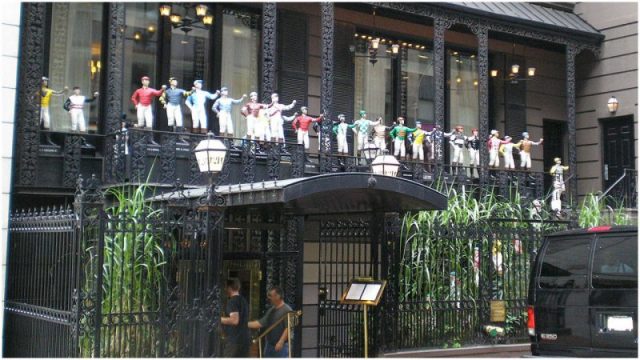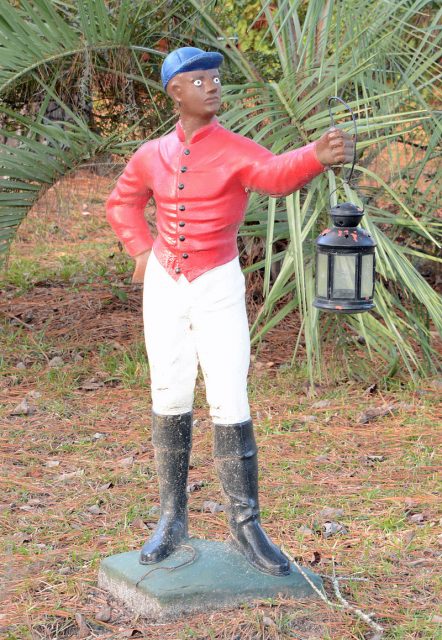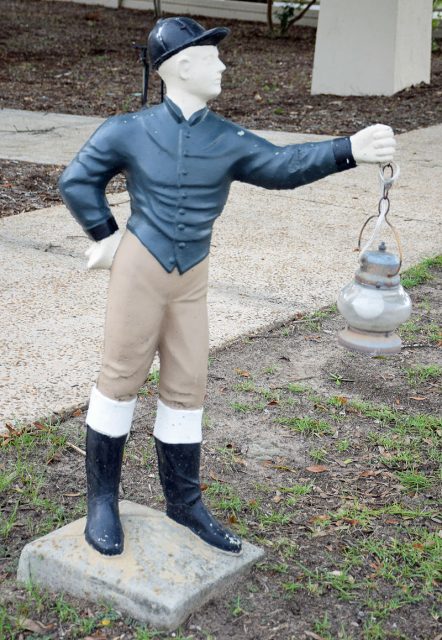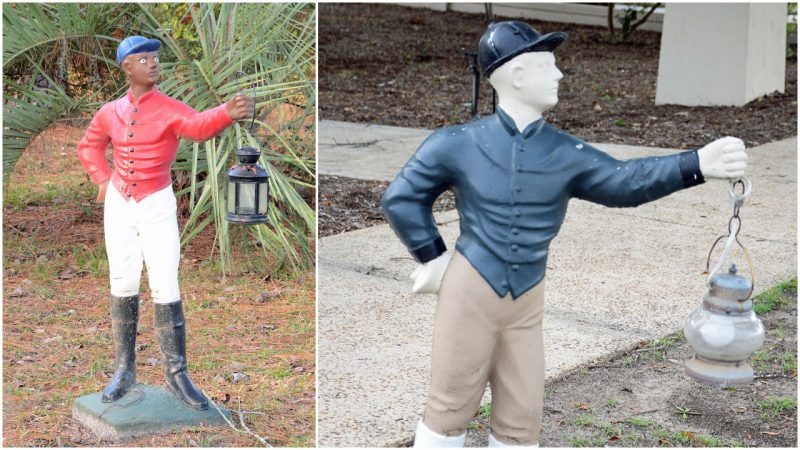They’ve been around for hundreds of years. You still see them in some front yards in parts of the United States and 33 of them line the wrought-iron entrance to the 21 Club, New York City’s famous former speakeasy. They are lawn jockeys, or men, dressed in riding silks, their right or left arm extended up holding a ring or a lantern. Depending on their color and the cut of their cloth, they are either a nostalgic nod to historic hospitality or a hated symbol of racism. Context is everything.
Starting in the 18th century, lawn jockeys were cast of solid iron or zinc, weighed 300 or more pounds, and were used as hitching posts most frequently in front of tobacco shops. The U.S. Patent Office issued patent no. 5,875 to Robert Wood of Philadelphia in 1872 for a “hitching post in the form, shape, and costume of a ‘Jockey.’ ”
Three major manufacturers in New York and Pennsylvania marketed their products through catalogs. A 1910 catalog showed three variations emblematic of the times (and hopelessly stereotypical to modern eyes): a white jockey, wearing natty silks and riding helmet; a Chinese man, holding a folding fan and wearing a peaked straw hat and sandals; and a barefoot black servant draped in work clothes.

The origin of the black jockey has been linked to the legend of Jocko Graves, a young boy helping George Washington in the Revolutionary War. In this story, a 12-year-old Jocko follows his father to join General Washington’s Army as it crosses the Delaware River on Christmas Eve 1776. The general won’t allow the young man to fight and instead orders him to stand on the riverbank holding a lantern, so the men will know the way back to camp after battle. When they return two days later, they find that the loyal young Jocko has frozen to death, still clutching the lamp. Washington was then said to have created an iron likeness of Jocko as a hitching post, “The Faithful Groomsman.”
There is no evidence that Jocko Graves existed. Historians point out the story is apocryphal, as are many Washington legends, meant to prove the American founder’s generosity of spirit.
During the 1800s, the lawn jockey evolved from a boy in a work shirt and jeans to an obsequious black servant with caricatured eyes and lips (an offensive depiction today) to an upright white man in fancy riding silks. It is, unsurprisingly, this last type of jockey that stands outside New York’s 21 Club.

Photo: Jud McCranie -CC BY-SA 4.0
Another fanciful legend posits that the lawn jockey was used in Underground Railroad years to signal safety or danger to runaway slaves. The jockey’s arm pointed to safe houses. A scarf tied to the jockey’s ring served as a message.
“These statues were used as markers on the Underground Railroad throughout the South into Canada,” historian and author Charles Blockson, curator of the Afro-American Collection at Temple University in Philadelphia, told the Lexington Herald-Leader. “Green ribbons were tied to the arms of the statue to indicate safety; red ribbons meant to keep going.”
Blockson, the great-grandson of a slave who escaped to Canada on the underground railroad, said lawn jockeys stood outside rich people’s houses on Philadelphia’s Main Line and on the streets of his own neighborhood of Norristown when he was growing up. He told the Washington Post in 2006, he hated the sight of them.

Photo: Jud McCranie CC BY-SA 4.0
“People who don’t know the history of the jockey have feelings of humiliation and anger when they see the statue,” Blockson said. “But this figure which was sometimes used in a clandestine nature, and sometimes without the knowledge of the person who owned the statue, was a positive and supportive image to African-Americans on the road to freedom.”
It’s a cool story but unverifiable and even problematic, as pointed out by the Jim Crow Museum of Racist Memorabilia at Ferris State University, which reminded readers that runaway slaves traveled at night, making colors difficult to discern.
Red and green scarves were used as railroad signals in World War I, long after the Underground Railroad. David Pilgrim, the Jim Crow Museum’s curator did acknowledge that the lawn jockey’s use as a signal wasn’t impossible. “Given that slavery lasted more than two hundred years, it is likely that it happened at least once,” Pilgrim wrote in 2008. “Nevertheless, there is little evidence that this practice was widespread.”
In the early 1910s, the lawn jockey went the way of the carriage—that is to say, killed off by the advent of automobile travel.
E.L. Hamilton has written about pop culture for a variety of magazines and newspapers, including Rolling Stone, Seventeen, Cosmopolitan, the New York Post and the New York Daily News. She lives in central New Jersey, just west of New York City
